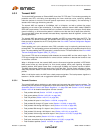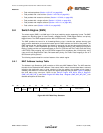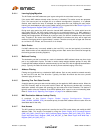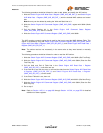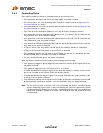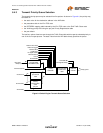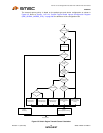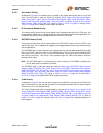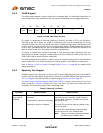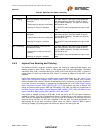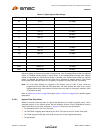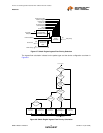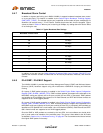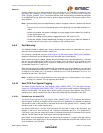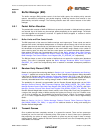
Two Port 10/100 Managed Ethernet Switch with 16-Bit Non-PCI CPU Interface
Datasheet
Revision 1.4 (08-19-08) 70 SMSC LAN9311/LAN9311i
DATASHEET
6.4.4 VLAN Support
The switch engine supports 16 active VLANs out of a possible 4096. The VLAN table contains the 16
active VLAN entries, each consisting of the VID, the port membership, and un-tagging instructions.
On ingress, if a packet has a VLAN tag containing a valid VID (not 000h or FFFh), the VID table is
searched. If the VID is found, the VLAN is considered active and the membership and un-tag
instruction is used. If the VID is not found, the VLAN is considered foreign and the membership result
is NULL. A NULL membership will result in the packet being filtered if Enable Membership Checking
is set. A NULL membership will also result in the packet being filtered if the destination address is not
found in the ALR table (since the packet would have no destinations).
On ingress, if a packet does not have a VLAN tag or if the VLAN tag contains VID with a value of 0
(priority tag), the packet is assigned a VLAN based on the Port Default VID (PVID) and Priority. The
PVID is then used to access the above VLAN table.
The VLAN membership of the packet is used for ingress and egress checking and for VLAN broadcast
domain containment. The un-tag instructions are used at egress on ports defined as hybrid ports.
Refer to Section 14.5.3.8, on page 377 through Section 14.5.3.11, on page 380 for detailed VLAN
register descriptions.
6.4.5 Spanning Tree Support
Hardware support for the Spanning Tree Protocol (STP) and the Rapid Spanning Tree Protocol (RSTP)
includes a per port state register as well as the override bit in the MAC Address Table entries (Section
6.4.1.5, on page 64) and the host CPU port special tagging (Section 6.4.10, on page 75).
The Switch Engine Port State Register (SWE_PORT_STATE) is used to place a port into one of the
modes as shown in Table 6. 2. Normally only Port 1 and Port 2 are placed into modes other than
forwarding. Port 0 should normally be left in forwarding mode.
Figure 6.6 VLAN Table Entry Structure
Table 6.2 Spanning Tree States
Port State Hardware Action Software Action
01 - Blocking
(also used for
disabled)
Received packets on the port are
discarded.
Transmissions to the port are blocked.
Learning on the port is disabled.
The MAC Address Table should be programmed
with entries that the host CPU needs to receive
(e.g. the BPDU address). The static and override
bits should be set.
The host CPU should not send any packets to the
port in this state.
The host CPU should discard received packets
from this port when in the Disabled state.
Note: There is no hardware distinction between
the Blocking and Disabled states.
17 16 15 14 13 12
VID
11 0
...
Un-tag
MII
Member
MII
Un-tag
Port 1
Member
Port 1
Un-tag
Port 2
Member
Port 2



